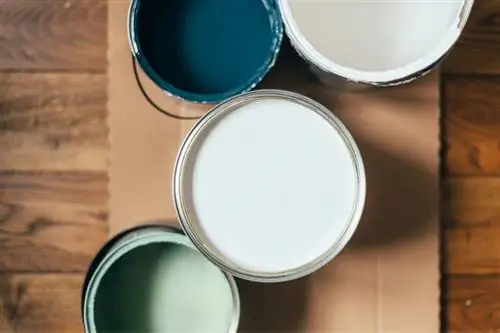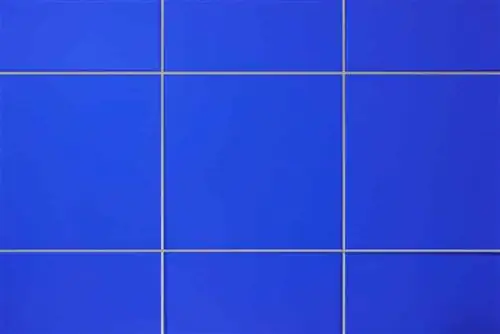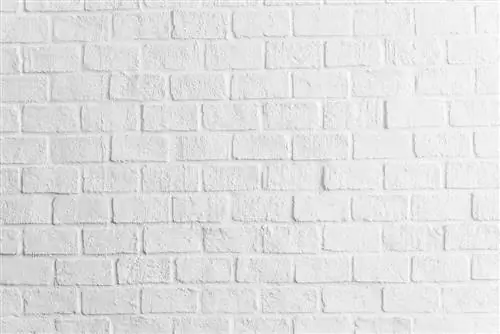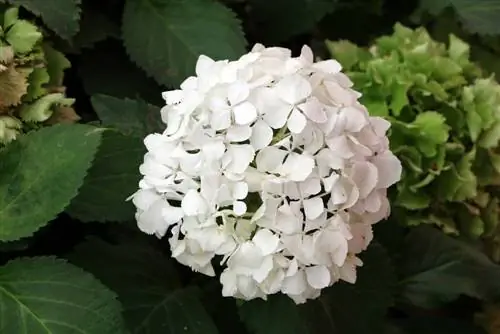- Author admin [email protected].
- Public 2023-12-17 03:39.
- Last modified 2025-01-24 12:45.
Opacity is an important factor when using wall paints. Emulsion paints in particular are known for their good coverage, but are sometimes too thick or sticky to apply. For this reason, it is important to properly dilute wall paint.
Recommended water quantity
Emulsion paints have the great advantage that they are manufactured ready for use. This means they do not need to be mixed or diluted to use. However, it may be necessary to dilute it with water if one of the following reasons applies:
- too thick
- sticky
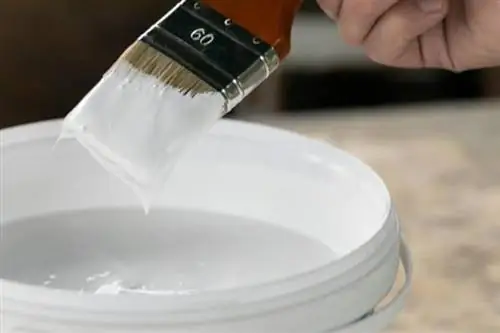
In this case it is worth adding water, otherwise the wall paint cannot be applied properly or it may form lumps on the wall. Fortunately, water usually does not have a negative effect on the opacity of emulsion paints as long as you pay attention to the mixing ratio. Emulsion paint can be mixed with a maximum of ten percent water to dilute it. More water is not recommended, otherwise sufficient coverage will no longer be possible. It can also happen that the paint splashes or runs down quickly when it is applied. The maximum recommended amount can be determined quickly and effectively. For example, if you have purchased 25 liters of wall paint and want to dilute it, you should use a maximum of the following amount of water:
- 10% water for 25 liters of paint
- Total amount of water in l=25 x 0.1 (corresponds to 10%)
- 2, 5 l water
Note:
As a precaution, pay attention to any manufacturer information on the packaging when it comes to the amount of water. If a different guideline value is specified there, use this to obtain sufficient opacity.
Diluting emulsion paint: instructions
Diluting emulsion paints can be done with little effort. When diluting, it doesn't matter whether the selected emulsion paint was mixed with solvents or not. Once you have determined the amount of water, you can get started. The following instructions will guide you through the individual steps:
- Open the paint bucket and stir the wall paint thoroughly. The result should be a homogeneous mass with no lumps. This makes it easier to absorb the water for dilution. For example, you can use sticks for stirring, which must be sufficiently robust.
- Fill the maximum recommended amount of water into a measuring container. This makes it easier to regulate the amount added because you don't pour everything into the paint at once.
- Now add some of the water. To start with, five percent is recommended, which corresponds to 1.25 liters of water for a 25 liter paint bucket.
- Stir the water thoroughly into the paint. During the mixing process, check whether the consistency changes. If the paint was too sticky to apply before adding the water, it should now be much easier to use.
- Add the rest of the water to the paint in increments until it reaches the desired consistency. Once the water has been used up, you should not add more, otherwise sufficient coverage will no longer be possible. Continue to stir well so that the paint is suitable for further use.
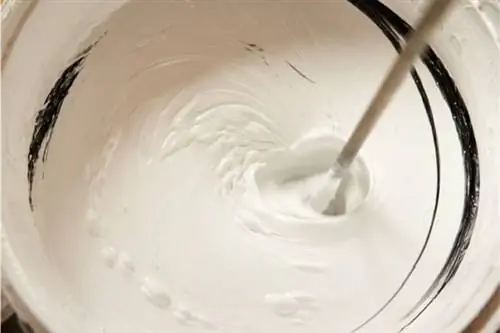
Diluting other types of wall paints
Emulsion paints are not the only types used as wall paint. There are other types of paint that you can use for painting. However, not all of these are suitable for thinning as they quickly lose their opacity. Wall paints based on lime (chalk paints) and clay are particularly problematic. The opacity of these colors decreases steadily as they are diluted. For this reason, several coats are often necessary to achieve the desired coverage. In addition to these, there are other wall paints that can be mixed with the appropriate thinners.
This includes:
- Silicate paint
- Dispersion silicate paint
Water is not enough for these colors because it does not support carbonation. For this reason, you need suitable thickeners based on potassium silicate. If you want to use latex wall paint instead, you can dilute it with water. This works in the same way as with emulsion paints, but you have to observe a different mixing ratio. Add between 20 to 30 ml of water per liter of paint. For a quantity of ten liters, calculate the amount of water as follows:
- Total amount of water: 20 to 30 ml of water per 1 liter of paint
- 20 to 30 ml water x 10 l paint
- Total quantity: 200 to 300 ml of water

Note:
If you use diluent, be sure to follow the manufacturer's instructions regarding mixing ratio and application. This guarantees that the desired coverage is maintained.
Frequently asked questions
Can dried wall paint be diluted?
Usually not. Only water-based paints such as chalk or clay paints allow this. For example, emulsion paints that have dried out because the lid is not closed precisely can no longer be thinned. It's similar with latex paints. Silicate paints usually only harden after use and not in the container. You should then dispose of dried wall paint properly.
Can too much water be removed from the paint?
No. If the paint is too thin, you need to thicken it. This is only possible with lime or talcum powder. With this you can gradually bind the color. Please note that the opacity cannot be restored in this way.

